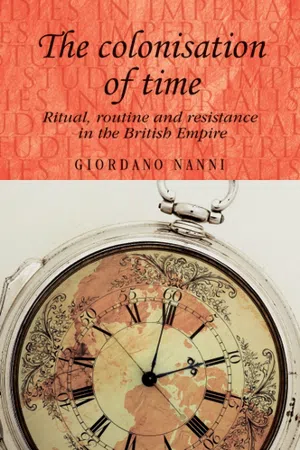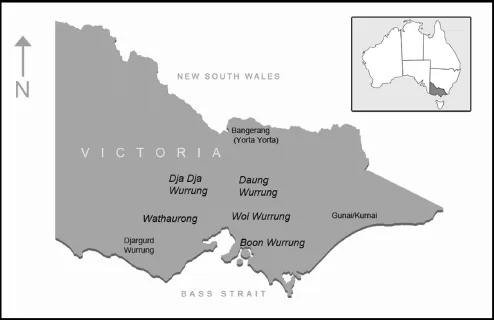The belief that ‘progress’ and ‘civilisation’ are correlated with the human capacity to transcend the limitations of nature is a mainstay of Western mythology and cultural commentary stretching back for cen-turies.1 Time – being a marker of civilisation – was no exception to this trend in nineteenth-century European discourse: the more a society was considered to be ‘civilised’, the greater the extent to which its calendars, discourses and computations of time were ‘reckoned without reference to any of the factors given by Nature’.2 As anthropologist Martin Nilsson stated in his early-twentieth century study, Primitive Time-reckoning (1920), abstract temporal units such as weeks, hours and minutes were signs of civilised society: ‘These artificial periods belong to a highly developed stage of time-reckoning’; whereas ‘stellar science and mythology [are] wide-spread among the primitive and extremely primitive peoples, and attain a considerable development among certain barbaric peoples.3 If, as this chapter argues, the ways in which non-European societies were understood to perceive and practise time were considered in Western scientific and popular discourse as markers of civilisation, then colonial understandings of Indigenous temporal cultures must have played a significant function in terms of determining which societies were thought to count as ‘civilised’ and which as ‘primitive’ (if, indeed, even ‘human’).
The original inhabitants of Australia already challenged the very limits of nineteenth-century European conceptualisations of humanity on a number of counts. ‘With the exception of the bushmen of South Africa,’ as a missionary in Australia wrote, ‘some suppose the aborigines of this country are about the lowest type of humanity. As the lowest savages they lived, without clothes, without care, without trouble for temporalities, subsisting on the simple products of nature without let or hindrance.’4 Aboriginal ideas about time, rituals, rhythms and discourses – structured as they were primarily around natural rhythms -contributed to the portrayal of the Aborigine as a ‘savage’ – indeed as something other than human, ‘where to be human was to be separate from nature’.5 Given that in the nineteenth-century British metropolis, as we have seen, nature itself was generally coming to be regarded as a ‘bad’ timekeeper compared to the time provided by the railways, such closeness to nature resulted in the representation of Aboriginal societies as innately ‘irregular’ and ‘erratic’, evincing a sense of timelessness and aimlessness that implied a failure of understanding and a lack intelligence rather than an alternative way of ordering life.
Such representations of Aboriginal societies contributed to their depiction in terms of extreme deficiency, precisely at a time when European jurisprudence was busy interpreting such deficiencies as a justification for colonisation. This logic was manifested to its clearest extent in the Australian colonies, where representations of nomadic hunter-gatherers within frameworks of lack and absence constituted the ‘legal’ foundation for British occupation. Indeed, the legal doctrine of terra nullius (lit. ‘no one’s land’), which the British Crown had invoked in order to justify its occupation of the Australian continent, was couched primarily within a discourse of lack – in this case of property rights – since European jurisprudence did not regard land as ‘owned’ unless its inhabitants had visibly enclosed, developed, irrigated and thus ‘improved’ it through human labour.6 If these criteria were not met, ‘the inhabitants were not so much a society as legally transparent entities so that, for ownership purposes, the land belonged to nobody’.7 Such views stemmed from a profound ignorance and disapproval of Aboriginal land-use, as well as of the rhythms that guided Aboriginal people as they moved over, and drew sustenance from, that land. Settlers staking a claim to the land, asserted that they could see no sign of permanent settlement, no evidence of ownership, no enclosure and no agriculture (terra nullius); but they also claimed that they could sense no rational rhythm and no regularity or periodicity in the nomadic life: terra sine tempore – a timeless land.
Australian historians Bain Attwood and Maureen Perkins have pointed out that the notion of Aboriginal societies as ‘timeless cultures’ reinforced the fiction of terra nullius: ‘Time and space were intimately related,’ Perkins writes, ‘the absence of one a precondition for the absence of the other.’8 In analysing colonial constructions of ‘Aboriginal time’, this chapter seeks to deepen our understanding of the ways in which colonial constructions of ‘Aboriginal time’ helped bolster the fiction of Australia as terra nullius by portraying its inhabitants as a natural, rather than a cultural, presence – with a tenuous and temporary attachment to the land.
‘Aboriginal time’ before the time of settlement
It is commonly said, even today, that the four seasons in Australia are the ‘reverse’ of those in Europe. But this is merely a symptom of the myth that time the world over is defined in relation to Europe. Australia’s seasons are in fact not four in number. ‘We have six seasons,’ explains a member of the Mirrar people in Arnhem Land, in the north of Australia. ‘But our seasons don’t come regular like they do for the balanda [white people]. We know when it begins because Yamidji the green grasshopper, he call out that cheeky yams are ready.’9 The six seasons of Arnhem Land, moreover, are different from the six seasons observed by the Noongar peoples in the southwest of the continent; different again are the five seasons in the northwestern Kimberley region and the eight others in the Cape York peninsula. In the southeast, where the city of Melbourne now stands, the Kulin peoples recognised seven seasons, each of a different length, according to the appearance of specific flora and fauna: Kangaroo-apple Season, corresponding roughly to the month of December, Dry Season (around January–February), Eel Season (around March), Wombat Season (approximately April–August), Orchid Season (September), Tadpole Season (October), and Grass-flowering Season (around November). Two longer, overlapping seasons were also recognised: fire (approximately every seven years) and flooding (approximately every 28 years).10
The fact that most Australians today are almost entirely unaware of the existence of such seasons in their respective parts of the continent is a symptom of the ongoing structures of colonisation; for only until very recently, the myth of terra nullius encouraged a denial of the existence of pre-colonial Indigenous institutions. The perception that Europeans had introduced time, calendars and seasons to Australia was forged during the infancy of British settlement. In actual fact, all that could be truthfully claimed is that, at the time of British settlement in 1835, there had been no clocks, watches and bell-towers in Victoria (or rather, the Port Phillip District of New South Wales, as it was known by settlers until its proclamation as a separate colony in 1851).
In spite of this, and although they were said to possess no equivalent words for the concept of ‘time’, the original inhabitants of southeastern Australia observed multiple, well-established and rigidly respected times for the holding of celebrations, the heralding of gatherings and the undertaking of journeys across the land. Such movements were based on an intimate knowledge of nature’s rhythms, which allowed for groups to accurately estimate, among other things, the distances that were to be covered by foot, the seasonal availability of resources, the reproductive rhythms that determined the edibility or toxicity of the vegetation, and the feeding habits and migration patterns of the fauna.11 Indeed, pre-colonial time was coordinated by an understanding of social and ecological cycles and patterns that were by no means limited, haphazard or primitive.
Much of this can be gleaned from the reports of a handful of observant colonial writers, such as George Augustus Robinson, Chief Protector of Aborigines in the Port Philip District. Robinson described how ‘the Natives of the Low Country and of the Mountains assemble in large numbers in the fine Season to collect the Bogong fly, a species of Moth [that is] extremely nutritious, and the Natives subsist during the season entirely upon them’.12 One of Robinson’s Assistant Protectors, William Thomas, recalls how the Kulin used to build ‘very large barques and cross over Western Port to French Island at a certain season of the year after eggs’.13 Edward M. Curr, a squatter in Victoria, described how members of the Bangerang people ‘erected annually fishing weirs, at the proper season’, during the flood-waters period.14 Some of the more perceptive observers also noted that these events marked the times for Kulin social, economic and religious gatherings.15 Thus events like the annual swarming of the Bogong moth in the Victorian Alps were also a time for initiation ceremonies, corroborees, trade, marriages and the settling of disputes. As William Thomas put it, ‘in Australia there is not a month but some tree, shrub, or flower is in blossom – and for exact assembling they calculate and arrange time in the latter way’.16
Astronomical knowledge provided a fundamentally important means of marking the passage of time in pre-colonial Australia. James Dawson, a settler in the western District of Victoria – an area originally inhabited by the Djargurd Wurrung people – provided a perceptive description of the manner in which the movements of stars helped to configure the temporal landscape of pre-colonial life:
Although the knowledge of the heavenly bodies possessed by the natives may not entitle it to be dignified by the name of astronomical science, it great...

